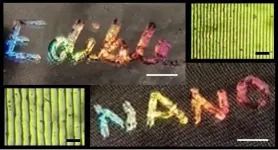Advances in x-ray imaging can help patients with breast cancer
2021-02-17
(Press-News.org) A new X-ray imaging scanner to help surgeons performing breast tumour removal surgery has been developed by UCL experts.
Most breast cancer operations are what are known as conserving surgeries, which remove the cancerous tumour rather than the whole breast. Second operations are often required if the margins (edges) of the extracted tissue are found to not be clear of cancer.
Researchers at UCL, Queen Mary University of London, Barts Health NHS Trust and Nikon used a new approach to x-ray imaging which allows surgeons to assess extracted tissue intraoperatively, or during the initial surgery, giving 2.5 times better detection of diseased tissue in the margins than with standard imaging.
In the paper, published today in Scientific Reports, academics use X-Ray Phase Contrast Imaging (XPCI), developing a scanner which provides surgeons with a full 3D image of the extracted tissue lump, known as a wide local excision (WLE).
Currently, the WLE is assessed through histopathology - the microscopic examination of tissue - with results only available after several days. If affected margins are detected, often a second operation is required.
Lead author Professor Alessandro Olivo (UCL Medical Physics & Biomedical Engineering) said: "I am terribly excited about these results, as they are likely to lead to the first clinical use of XPCI. The technology has tremendous potential, and I am sure once people see what it can do many other clinical areas will follow suit."
So far, most proposed approaches to allowing an intraoperative assessment had too many shortcomings to be effective, either in the ability to detect all of the diseased tissue or in achieving a sufficient penetration depth in the specimen, or in both.
Researchers tested the scanner on 101 WLEs and compared the results with the current standard method used intraoperatively (based on conventional x-rays). The superior detection rate of 2.5 times could result in a similar reduction in the re-operation rate.
Co-author Professor Louise Jones (Director, Breast Cancer Now Tissue Bank) said: "This technology has the potential to significantly improve radiological intraoperative assessment of tumour margins, potentially reducing the need for repeat operations that many patients require, which can cause significant distress to the patient."
Co-author Tamara Suaris (Consultant Breast Radiologist, Barts NHS Health Trust) added: "Although we have focused on the impact of XPCI in breast surgery, there is a much wider clinical potential of this technology including other intraoperative areas such as intestinal, oesophageal and prostatic surgery and in the longer term, diagnostic imaging, notably mammography."
XPCI imaging provides soft tissue sensitivity which is superior to conventional x-ray. Whereas standard imaging picks up the x-ray beam's change in intensity as it travels through tissue, phase contrast imaging measures the changes in speed with which x-ray travels through different tissues, which has been proven to enhance soft tissue contrast, including of breast tumours.
The work was supported by the Wellcome Trust, Royal Academy of Engineering and the Royal Society. Tissue samples were collected and made available by the Breast Cancer Now Tissue Bank, donated by anonymous patients.
INFORMATION:
[Attachments] See images for this press release:

ELSE PRESS RELEASES FROM THIS DATE:
2021-02-17
Polyisobutenyl succinic anhydrides (PIBSAs) are important for the auto industry because of their wide use in lubricant and fuel formulations. Their synthesis, however, requires high temperatures and, therefore, higher cost.
Adding a Lewis acid--a substance that can accept a pair of electrons--as a catalyst makes the PIBSA formation more efficient. But which Lewis acid? Despite the importance of PIBSAs in the industrial space, an easy way to screen these catalysts and predict their performance hasn't yet been developed.
New research led by the Computer-Aided Nano and Energy Lab (CANELa) at the University of Pittsburgh Swanson School of Engineering, in collaboration with the ...
2021-02-17
Wearable sleep tracking devices - from Fitbit to Apple Watch to never-heard-of brands stashed away in the electronics clearance bin - have infiltrated the market at a rapid pace in recent years.
And like any consumer products, not all sleep trackers are created equal, according to West Virginia University neuroscientists.
Prompted by a lack of independent, third-party evaluations of these devices, a research team led by Joshua Hagen, director of the Human Performance Innovation Center at the WVU Rockefeller Neuroscience Institute, tested the efficacy of eight commercial sleep trackers.
Fitbit and Oura came out on top in measuring total sleep time, total wake ...
2021-02-17
SAN ANTONIO -- Patients should be assessed for frailty before having many types of surgery, even if the surgery is considered low risk, a review of two national patient databases shows.
Frailty is a clinical syndrome marked by slow walking speed, weak grip, poor balance, exhaustion and low physical activity. It is an important risk factor for death after surgery, although the association between frailty and mortality across surgical specialties is not well understood.
The study, conducted by faculty at multiple institutions including The University of Texas Health Science Center at San Antonio (UT Health San Antonio), mined patient data from the Veterans Affairs (VA) Surgical Quality Improvement Program and the American College of Surgeons (ACS) National Surgical Quality ...
2021-02-17
The millions of people affected by 2020's record-breaking and deadly fires can attest to the fact that wildfire hazards are increasing across western North America.
Both climate change and forest management have been blamed, but the relative influence of these drivers is still heavily debated. The results of a recent study show that in some ecosystems, human-caused climate change is the predominant factor; in other places, the trend can also be attributed to a century of fire suppression that has produced dense, unhealthy forests.
Over the past decade, fire scientists have made major progress in understanding climate-fire relationships at large scales, such as across western North America. But a new paper published in the journal Environmental Research ...
2021-02-17
ROCHESTER, Minn. -- Mayo Clinic researchers have developed a novel proton therapy technique to more specifically target cancer cells that resist other forms of treatment. The technique is called LEAP, an acronym for "biologically enhanced particle therapy." The findings are published today in Cancer Research, the journal of the American Association for Cancer Research.
"The human body receives tens of thousands of DNA lesions per day from a variety of internal and external sources," says Robert Mutter, M.D., a radiation oncologist at Mayo Clinic and co-principal investigator of the study." Therefore, cells have evolved complex repair pathways to efficiently repair damaged DNA. Defects in these repair pathways ...
2021-02-17
With the seemingly unstoppable advancement in the fields of miniaturization and materials science, all sorts of electronic devices have emerged to help us lead easier and healthier lives. Wearable sensors fall in this category, and they have received much attention lately as useful tools to monitor a person's health in real time. Many such sensors operate by quantifying biomarkers, that is, measurable indicators that reflect one's health condition. Widely used biomarkers are heartrate and body temperature, which can be monitored continuously with relative ease. On the contrary, ...
2021-02-17
Holograms are everywhere, from driver's licenses to credit cards to product packaging. And now, edible holograms could someday enhance foods. Researchers reporting in ACS Nano have developed a laser-based method to print nanostructured holograms on dried corn syrup films. The edible holograms could also be used to ensure food safety, label a product or indicate sugar content, the researchers say.
Most holograms are imprinted with lasers onto metal surfaces, such as aluminum, but the materials aren't edible. For foods, holograms made with nanoparticles have been proposed, but the tiny particles can generate reactive oxygen species, which might be harmful for people to eat. In a different approach, food scientists have ...
2021-02-17
ROCHESTER, Minn. -- A new study by Mayo Clinic researchers has identified that a chromosome instability gene, USP24, is frequently missing in pediatric patients with neuroblastoma, an aggressive form of childhood cancer. The finding provides important insight into the development of this disease. The study is published in Cancer Research, the journal of the American Association for Cancer Research.
"Neuroblastoma is a highly aggressive cancer that nearly exclusively affects young children," says Paul Galardy, M.D., a pediatric hematologist and oncologist at Mayo Clinic. Despite the use of multiple treatment approaches, Dr. Galardy says many children die of this disease every year.
To identify new ...
2021-02-17
A mutation in the spike protein of SARS-CoV-2--one of several genetic mutations in the concerning variants that have emerged in the United Kingdom, South Africa, and Brazil--makes the virus up to eight times more infectious in human cells than the initial virus that originated in China, according to research published in the journal END ...
2021-02-17
Scientists have discovered a never-before-seen biodiversity pattern of coral reef fishes that suggests some fishes might be exceptionally vulnerable to environmental change.
A new study shows plankton-eating coral reef fishes (planktivores) are far more diverse than others in the Indo-Australian Archipelago, a global marine biodiversity hotspot.
The findings highlight, for the first time, a unique link between the diet and distribution of species across the marine realm.
"The archipelago is one of the most complex and dynamic geological regions in the tropics," said lead author Dr Ale Siqueira from the ARC Centre of Excellence for Coral Reef Studies at James Cook University (Coral CoE at JCU). "And its ...
LAST 30 PRESS RELEASES:
[Press-News.org] Advances in x-ray imaging can help patients with breast cancer





